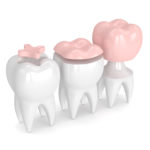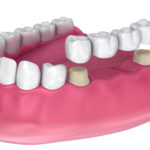Cosmetic Dentistry – smile for life

Are you unhappy with your smile? Do you smile less because of your teeth? You’re not alone. Many studies confirm that if you have aesthetic problems with your teeth it can affect everything from how you smile to your self-esteem and confidence
From less complex to very complex issues, the great news is that just about every aesthetic dental problem can be solved
It’s never too late to have that beautiful smile, and if you wish to improve yours there are many options:
Common Concerns and Treatments
Porcelain Inlays

Our cosmetic dentistry treatments

We can easily remove unsightly surface stains from teeth.
Gum disease is one of the most common causes of tooth loss in adults – not to mention bad breath and bleeding gums
It’s caused by plaque – the bits of food and bacteria left on our teeth every day. This can be removed with regular tooth brushing. However, if left untreated plaque combines with saliva and forms hard deposits and stains on the teeth known as tartar or calculus. Tartar cannot be removed by brushing and needs professional removal by your dentist
Gingivitis is the inflammation and bleeding of gums and is a direct consequence of plaque and tartar. This early stage of gum disease if not treated may well lead to periodontitis, a serious disease that involves gum deterioration, jaw bone loss and loss of teeth.
A regular professional clean will remove all plaque, calculus (tartar) and any stains that have built up over time on and between your teeth and help to keep teeth looking clean and bright.
How often you should have a professional scale and clean?
This depends on the state of your teeth, your oral hygiene and your diet. Your dentist will advise you how often you should have a scale and polish but generally every 6-12 months
Things that you can do to help keep your teeth whiter between appointments
- Limit food and drinks that can stain teeth: Tea, coffee, red wine
- Stop smoking
- Practice good dental hygiene
How much does a professional scale and clean cost?
The cost will vary according to whether our dentists need to do a heavy clean or a lighter clean. This decision is based on your age and the observations and x-rays taken by the dentist. If your dental hygiene habits are good and your diet is OK this will help to reduce your costs
Generally, costs range from $51 to $180
While everyday foods and drinks can cause the discolouration of your teeth there are a few main culprits that can speed up the yellowing process. One of the leading causes is smoking, followed by coffee, tea, colas as well as certain medications. Not all discoloration is your fault, in some cases it can be caused by getting older, genetics, as well as the water you drink. No matter the cause, the process is gradual and what may start as a dull white can still end up turning an unhealthy looking yellow or brown.
There are many options available to you for whitening your teeth, some are more successful than others! Our dentists recommend and use the Opalescence whitening system which has been clinically proven to lighten the colour of your teeth and produce beautiful smiles with less tooth sensitivity
Don’t play games with your dental health or put trust in those who are not qualified to carry out treatments. The team at Riversdale Dental are experienced in carrying out this and other cosmetic treatment which when done correctly can be highly effective at whitening your teeth and producing positive results.
The resulting discolouration can occur years after the root canal is finished and is not able to be corrected by the traditional whitening methods. Regardless of the cause, there are still opportunities to restore such a tooth to match the colour of its adjacent teeth, by bleaching the tooth from the inside-out – a process known as internal bleaching.
Although internal bleaching can achieve a dramatic result by altering and improving the appearance of a tooth, a perfect colour to the teeth either side is hard to attain.
What is internal bleaching?
Internal tooth bleaching is where the bleaching takes place from within the tooth. The process is safe, straight forward and lasts for a number of years
How does it work?
Our experienced dentists make a small incision into your tooth and the tooth canals are properly cleaned and sealed before an oxidising chemical is inserted into the pulp of the tooth. After a few days the dentists will establish if the whitening has been effective or if additional dose of whitening chemical is required.
The process varies slightly depending on whether the tooth in question is stained because of prior root canal treatment, or because it’s in need of root canal treatment.
The procedure cannot be performed if there is an infection affecting the tooth. The infection has to be treated first.
While amalgam is increasingly giving way to tooth-coloured filling materials such as composite, it is still in use and safe so there is no need to replace your amalgam fillings just for the sake of it.
Amalgam fillings are made up of a mixture of metals. They typically contain about 50 percent mercury, along with tin, copper, silver or zinc. They are very strong and long lasting however, they can blacken with age and being silver in colour they can be obvious when you open your mouth.
If you would like to achieve a completely natural-looking set of teeth we are able to provide you with an amalgam replacement service.
A white filling/composite bonding can be used in many types of situations such as:
- fillings
- amalgam replacement
- gaps between teeth
- repairing tooth fractures
- reshaping misshapen teeth
- masking discoloured teeth
- composite veneers
How does it happen?
To begin the procedure your tooth is treated to make it sticky, allowing the composite to ‘bond’ with your tooth. Once applied, the composite is shaped or formed as required. When your dentist is satisfied with the result, the composite is then cured with blue light so it becomes hard, before being trimmed and polished on the spot. The whole treatment is usually able to be completed within one appointment.
Advantages
- White in colour
- Versatile
- Some people appreciate they are mercury free
Limitations
- Can be a bit fragile when bigger in size
- For the reason above, when used as a filling they are best suited for teeth that experience a moderate amount of pressure when chewing, compared to teeth that handle the bulk of your chewing action.
Fillings vary in complexity and material. Talk to our experienced dentists when making a decision and let them help and advise you about the best choices available for your teeth
The difference between them is how much of your tooth must be cut away before the inlay/onlay can be installed. For this reason, they are a more conservative than crowns because less tooth structure is removed in the preparation of inlays & onlays. However, the final decision must be based on our much damage or decay is present in the tooth and which option has the best chance of long term success.

As with most dental restorations, inlays are not always permanent and may someday require replacement. They are highly durable and will last many years, giving you a beautiful, long lasting smile.
What does getting an inlay or onlay involve?
It usually takes two appointments to make an inlay. During your first appointment your dentist will take impressions of your tooth. Your impressions along with details on the shape, size, colour and surface characteristics of your tooth are sent off to the laboratory where highly skilled technicians will make your inlay.
After two weeks your inlay is returned to us and we are able to remove the temporary filling and cement your inlay into place. Your dentist will also do a final check to ensure your inlay fits well within your tooth and your bite is comfortable and unaffected.
Reasons for needing an inlay/onlay restoration
- Broken or fractured teeth.
- Cosmetic enhancement.
- Decayed teeth.
- Fractured fillings.
- Large fillings.
How do I look after my inlay/onlay?
With good dental hygiene your inlay should over 10 years. Our experienced staff will give tell and show you how to look after your inlay but if you forget just give us a call. Good oral hygiene practices, a proper diet, and regular dental visits will aid in the life of your new inlay or onlay.
These ultra-thin porcelain shells are fixed onto the front of your teeth and can mask crooked, oddly-shaped, badly-aligned, broken, chipped, discoloured teeth or fill unsightly gaps. The transformation is often extraordinary.
There are two types of Veneers: Composite and Porcelain
Composite veneers or composite bonding can usually be done within one appointment as our experienced dentists are able to reshape the tooth, take the impression and bond the composite to shape your tooth during one appointment.
This process helps to keep the cost down as there are no external laboratory fees however, they can stain more easily, and they don’t reflect light in the same manner as porcelain and therefore usually don’t look as good. Their lifespan is about 7-8 years and they are more likely to chip than a porcelain veneer, however when a veneer is necessary, it is a good compromise between benefits and budget.
Benefits
- Cost
- Lifespan of 7-8 years
- Can be done within one appointment
Limitations
- Can stain more easily
- Don’t look as natural as a porcelain veneer
- More likely to chip
It is very important to discuss the benefits and limitations of composite veneers before making your decision on which way to proceed.
Porcelain veneers
Porcelain veneers are the most natural looking and aesthetically pleasing option and can take up to three appointments. Our experienced dentists are skilled at taking the impressions along with noting the details on the shape, size, colour and surface characteristics of your tooth. All this information is then sent off to the laboratory where highly skilled technicians will make your veneer. A well looked after veneer can last up to 15 years and much longer if your dental hygiene is good
Problems which can be corrected by a veneer or composite bonding
A veneer is a simple procedure which can correct many issues simply
- Small gaps between teeth
- Chips and cracks on teeth
- Stubborn discolouration that hasn’t responded to whitening
- Minor misalignment
- Mismatched teeth sizes
- Uneven tooth shapes
Benefits of a porcelain veneer
- Making teeth appear symmetrical
- Provide a smooth arc to your smile
- Provide a splint to a cracked tooth
- In some circumstances can be used as an alternative to braces
- A whiter smile
Advantages of a porcelain veneer
- Has the appearance of a natural tooth
- They are extremely thin (0.3-0.5mm thick) and require less of your natural tooth to be removed when compared to crowns
- Cheaper than a crown
- Porcelain veneers a resistant to stains
- Translucent giving a natural look
- They don’t normally aggravate the gum tissue or leave a dark line around the tooth
Disadvantages of a veneer
- A porcelain veneer is more expensive then composite bonding
- If a porcelain veneer becomes chipped or cracked it cannot be repaired and the next stage is a crown whereas a composite bonding can be repaired
- Without proper dental hygiene your tooth (behind the veneer) can still decay and you may need a crown in the future
- Your tooth may become sensitive to hot and cold because of the reduced enamel (this can be an issue with a porcelain veneer or composite bonding)
- They don’t last forever
Can everyone get veneers?
Veneers are not a good option if
- You grind or clench your teeth
- Have gum disease, oral infections or tooth decay
How do I look after my veneers?
Caring for your veneer is just like that of your other teeth
- Regular brushing
- Regular flossing
- Regular visits to the dentist for professional scale and cleans and to ensure your veneer remains healthy
- Avoid chewing on hard foods such as ice, betel nuts and hard candy because they can break the veneer and your natural teeth.
Some of the reasons you or your dentist may select a crown:
- Restore badly broken or decayed teeth allowing them to function correctly
- Protect cracked, chipped or fractured teeth
- Replace a missing tooth in conjunction with a dental bridge or implants
- Improve the appearance of poorly shaped teeth
- Cover discoloured teeth unable to be treated by more conventional bleaching
- Support teeth with large fillings when very little natural tooth is left
- Strengthen and protect root canal treated teeth
- Protect teeth which have more severe dental problems
A crown can be made from a variety of materials depending on the individual situation.
- Porcelain (ceramic)
- Precious metals such as gold
- Porcelain bonded to metal
Full porcelain crowns are the most natural looking and aesthetically pleasing option but they are not usually strong enough to survive the vigorous chewing we do on our rear teeth and so are generally reserved for the teeth towards the front of your mouth
Bridges are commonly used to replace one or more missing teeth by spanning the space where the teeth are missing.
What is a bridge?
Crowns are attached to the natural teeth or implants on both sides of the gap and one or more crowns (replacements teeth) are cemented together to cross the gap forming a bridge

Are there better solutions?
Missing teeth can have major consequences for your smile, your bite and your ability to chew food. The gaps they leave behind are prone to gum disease and the remaining teeth can rotate or shift into the empty spaces leading to bite disorders and even temporomandibular joint (TMJ) disorders. Eventually the jaw bone in this empty area wastes away which can cause a collapse of the lips and cheeks and aging your appearance.
There are a number of solutions for missing teeth which include the traditional crown and bridge treatment as well as implants and dentures.
These all vary considerably in cost, effectiveness and treatment times. Implants will be the most effective and aesthetically pleasing but also the most expensive. Dentures will be the most affordable but does not offer you the most natural aesthetic appearance or the bone loss prevention. Bridges can be a good compromise between cost and appearance.
Talk with your dentist to determine which solution suits you best in terms of the outcome you want, the longevity you are seek and the budget you wish to spend.
How long will my bridge last?
How long your bridge is strong and effective is entirely dependent on your oral hygiene routines. Dental bridges are worth the expense as long as you look after them. Take good care of your bridge and it could give you 15 years or longer of good service
Dentures are the cheapest alternative for the replacement of missing teeth and they can be used to replace entire sets of missing teeth (complete or full denture) or a small number of teeth (partial denture).
Although dentures are not fixed into place and are removable, they help restore function to the mouth, enabling people to eat normally, speak clearly and enjoy their smile. They also provide support for the cheeks and lips and can therefore be a good temporary or permanent option for the replacement of missing teeth
Missing teeth can have major consequences for your smile, your bite and your ability to chew food. The gaps they leave behind are prone to gum disease and the remaining teeth can rotate or shift into the empty spaces leading to bite or even temporomandibular joint (TMJ) disorders. Without replacing missing teeth, eventually the jaw bone in this empty area can waste away causing a collapse of the lips and cheeks and aging your appearance.
There are a number of solutions which include implants, crown and bridge constructions and dentures. These can vary considerably in cost, effectiveness and treatment times.
Advantages of dentures
- Cost
- A quick solution – in a very short time span you can have a beautiful smile
- Versatile – they can be used to replace everything from one missing tooth to many missing teeth
- They restore function to the mouth, enabling people to eat normally, speak clearly and enjoy their smile
- They provide support for the cheeks and lips and prevent them sagging inwards
Disadvantages of dentures
- Without any tooth roots or implants to keep the jawbone robust there will be bone loss over time – even if you have perfect oral hygiene.
- Requires adjustments over time
Implants are the best solution to missing teeth: they look and act like a natural tooth and help to maintain a healthy jawbone. Whilst they are the best option they are the most expensive and the treatment time from start to end is long – often months. However, a well looked after implant acts like a natural tooth, and with good oral hygiene it can last for the rest of your life.
A missing tooth is no laughing matter, it creates a gap that spoils your smile, it is likely to embarrass you and affect your confidence. And while low self-esteem is serious enough there are other negative consequences if you don’t do something about it:
- Neighbouring teeth can start tilting into the empty space
- Your bite can be affected and your ability to chew is reduced
- Lips and cheeks may collapse towards the space, making you look older
- The jaw bone may shrink where the tooth is missing
It’s important to get good advice about your options. Our dentists each have over 25 years’ experience and can discuss all the advantages and disadvantages which are relevant to your individual dental needs. Their knowledgeable advice will be invaluable as you assess the cost against the benefit for all the options and how they best fit within your budget.
What are the alternatives to an Implant?
Benefits of an implant
- It’s like having your own teeth, they look and feel completely natural in your mouth
- They help to keep dentures and bridges secure in your mouth which helps when speaking or eating
- When a tooth is lost, the bone which was once around that tooth will shrink away. Implants help to maintain the bone in your jaws and therefore the structure and outline of your face
- Because they are like a natural tooth, no food gets stuck underneath like it can do with a conventional bridge
- Dental implants can be a good alternative for those who find dentures or bridges uncomfortable, or who are unable to wear dentures due to the shape of their jaw
- Ordinary bridges require the teeth on either side of the gap to be modified (ground away) so they support their end of the bridge. An advantage of implants is that no adjacent teeth need to be prepared or ground down to hold your new replacement tooth/teeth in place.
Disadvantages of an implant
- The cost
- Not every case involving a missing tooth can be solved with an implant. To find out if you are a suitable candidate, a consultation will be necessary.
From a single tooth to replacing multiple missing teeth, dental implants can help restore your smile and preserve valuable bone.
We all have times of stress and anxiety which can often trigger teeth grinding or clenching whilst asleep. Severity can range from infrequent clenching to outright mashing.
Symptoms
There are many symptoms but here are some of the more commons ones we see:
- Worn-out tooth enamel
- Flat teeth
- Wear spots on teeth
- Sensitive teeth
- Jaw pain
- Earaches
- Tooth pain
- Chronic pain in the mouth or ear area
- Damage to insides of cheeks
- Tongue indentations
It may be possible to obtain some temporary relief by attempting the following
- Use a warm, wet washcloth on the jaw
- Massage jaw muscles, the neck, and face to relieve tension on trigger points
- Get some physical therapy
- Do exercises to relax the jaw
- Visit a physiotherapist/osteopath/chiropractor
- Use muscle relaxants to relax the jaw
Grinding can cause serious damage to otherwise healthy and well maintained teeth.
It is essential to protect the teeth by using a specially made grinding splint
Potential consequences of unchecked grinding can include
- Wearing down of teeth and enamel
- Loss of teeth
- Fracturing of teeth
- Aching jaws
- Recurring headaches
- Tooth pain
- Development of jaw joint disorders
Grinding splints
- We are able to make a custom mouth splint. These are immediately effective as the splint takes the brunt of the grinding and they stop the teeth being further damaged.
Benefits of a Grinding splints
- You save your teeth and therefore hugely reduce the chances of expensive dental repairs
Reducing the causes of Grinding
It’s also important to try and reduce the grinding so have a think about incorporating the following into your lifestyle:
- Reducing stress
- Drinking more water
- Getting more sleep
- Not chewing gum or other objects
- Consciously relaxing the face and jaw throughout the day
- Buying a teeth grinding splint
- Avoiding alcohol, which increases the urge to clench the teeth
- Avoiding caffeine, which can make you jumpy and tense
When teeth are crooked, out of alignment or in the wrong spot the use of orthodontics can be invaluable in returning your smile. There are now many options available to you and the braces can be less noticeable.
Some reasons for which you may need braces are
- Unsightly crowding
- Problems with bite alignment
- Unsightly spacing
- Trauma
Braces can be difficult to clean and broken braces require a trip to the orthodontist but doing both is vital in maintaining the integrity of your braces and your oral health during treatment so you can experience a wonderful outcome.
Here are some helpful hints:
- Use an electric toothbrush will help keep all your surfaces clean
- To clean under the wires easily use a small brush called ‘Piksters’
- Avoid hard foods such as nuts and hard biscuits.
- Foods such as apples and carrots should be grated or chopped into small pieces before eating to reduce the stress on your braces.
- Avoid sticky foods such as caramels, toffees, muesli or fruit bars. No chewing gum!
- Habits such as nail biting, unnatural tongue thrusting, pencil chewing and nervous picking at your wires can also break braces.
- Have regular check-ups with your dentist
If the teeth and braces are not kept clean there can be permanent changes to your teeth such as:
- Areas on the enamel surface may begin to lose minerals (the early stage of tooth decay) leaving unsightly white spots on your teeth at the end of treatment
- Teeth erosion can occur around the brace and when the braces are removed you are left with a square of different height in the centre of your tooth and a patch work appearance for your smile
Pain
Sometimes after appointments where the wires are adjusted there can be some pain. This can be managed with paracetamol (or your normal pain medication) and will usually only last 24 hours. If it lasts longer than a couple of days please contact your orthodontist.
What if my braces break?
If you get a broken wire which causes pain and or irritation, cover the loose end with wax, a small cotton ball, piece of gauze gum and get to your orthodontists as soon as possible
No matter the treatment is right for you, our experienced dentists at Riversdale dental can answer all your questions and help you to select the cosmetic dentistry option which best suits you. Find out more now and contact us on 9882 5566 to book an appointment.

